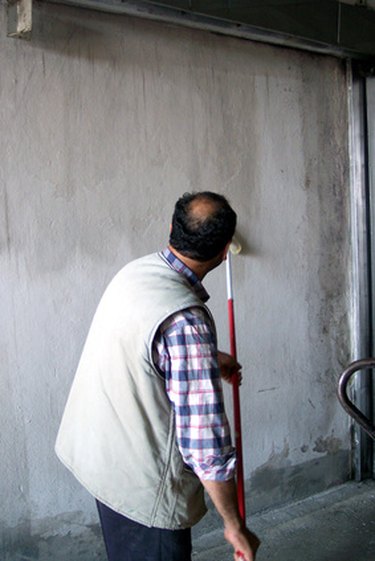Things You'll Need
Painting plastic
Painting tape
Sandpaper
Hammer
Rags
Bonding agent
Paint brushes
Paint rollers
Paint primer
Interior wall paint

Painting over stenciled walls can be a hassle. Stencils are often brightly colored, which creates shadows through new paint if care is not taken when painting over. Paint a stenciled wall like any other wall, but take particular care in sanding and priming. Don't try to rush a paint job; for a professional, clean finish, be meticulous and patient with each coat of paint.
Step 1
Clean dirt, dust or oil from the wall by wiping it with a damp rag. Remove tacks, nails, outlet and light switch covers, along with any other hardware you do not want painted.
Video of the Day
Step 2
Cove the entire floor with painter's plastic. Place tape around areas you do not want painted, such as windows and doors.
Step 3
Use sandpaper to dull or remove the paint from the stencils. You do not need to sand the whole thing. If the stencils are done in particularly light colors, you may skip this step altogether. If the stencils are large, sharp and bright, sand them down until you are sure that a tinted primer will fully cover them. Test the primer in an area until you are positive the stencils will not be seen through the paint.
Step 4
Fill any cracks in the plaster with the bonding agent. Sand the bonding agent to be flush with the wall.
Step 5
Apply primer liberally and evenly, and let it dry. If you can see the stencils through the first coat, apply another. Repeat this until the stencils are not visible.
Step 6
Apply the first coat of paint. Begin around the most intricate, difficult corners and edges, and then roll the large spaces. Allow this to dry fully, which will take between two and four hours, according to Be Jane, a home-improvement website for women.
Step 7
Apply a second coat if the paint is uneven or has runny spots.
Tip
According to Be Jane, priming is the most important step. Find a primer that is directed for you particular use. Use a tinted primer if the color you will be painting is dark. Ask the hardware store to mix one for your needs. Fully cover the stencils with primer. Always use new brushes and rollers for your paint instead of cleaning the used ones from the prime.
Video of the Day